The escalating conflict between President Donald Trump and billionaire entrepreneur Elon Musk continues to create uncertainty surrounding NASA's financial future. The White House has proposed substantial reductions to the space agency's budget, threatening to slice funding for scientific projects nearly in half. As the feud intensifies, Trump has suggested withdrawing federal contracts from Musk's SpaceX, a move that could ultimately undermine the entire U.S. space program.
NASA heavily relies on SpaceX's Falcon 9 rockets for transporting crew and supplies to the International Space Station (ISS) and is counting on its Starship rocket to fulfill aspirations of landing astronauts on the Moon as well as missions to Mars. Dr. Simeon Barber, a space scientist from the Open University, expressed that the current uncertainty is chilling for the agency, particularly for human space exploration. He emphasized that the chaotic dynamics observed recently are detrimental to the foundational collaborations essential for ambitious space projects.
Long before the fallout between Trump and Musk, there were apprehensions about the massive proposed budget cuts, which would leave around 40 ongoing scientific missions in jeopardy. Most areas of NASA's operations are set to face financial cuts, with the exception of the Moon and Mars missions, which enjoy an increase of $100 million. According to Casey Dreier, the chief of space policy for the Planetary Society, this budget proposal could pose an unprecedented crisis for the U.S. space program.
NASA's latest budget proposal reveals plans to reduce its budget by nearly 25%, aligning its resources primarily towards missions related to lunar and Martian exploration. Analysts like Dr. Adam Baker from Cranfield University commented that this shift positions NASA under a dual mandate to beat other nations to the Moon and Mars, effectively prioritizing these objectives over other scientific endeavors.
Supporters of the proposed budget argue it provides NASA with a much-needed sense of purpose reminiscent of the Apollo missions of the 1960s. Critics, however, claim the agency has become wasteful and inefficient over the years. Notably, NASA’s new Space Launch System (SLS) rocket, intended for returning astronauts to the Moon, has faced exorbitant costs and significant delays compared to private sector counterparts like SpaceX’s reusable Starship, which costs roughly $100 million per launch.
With SLS now facing potential phasing out, concerns arise over NASA's reliance on Elon Musk and Jeff Bezos’s companies to fill the gap. Dr. Barber cautioned that if these companies seek more government funding, Congress may feel pressured to comply.
Additionally, there are concerns regarding the ramifications for collaborative international projects, including missions undertaken by the European Space Agency (ESA). Losing 40 vital missions threatens to dismantle years of progress in understanding climate impacts and other planetary explorations. Missing out on collaborations like the return of Martian samples or Rosetta’s mission could have dire consequences for scientific understanding at a global level.
In light of the proposed cuts, ESA is contemplating an autonomous approach to space exploration, recognizing the need for independence from NASA. However, this shift could also mean reduced access to pivotal projects, including the lunar gateway and the International Space Station.
Dr. Baker highlighted the potential loss of Earth Observation programs, warning they serve as vital early warning systems for climate change, and their elimination would have catastrophic implications.
As Congress reviews the cuts, Dreier expressed concerns about political gridlock potentially delaying a budget approval, leading to a situation where the proposed budget may be implemented as a temporary measure that is difficult to reverse. The ongoing crisis thus presents a pivotal moment for NASA and the future of American space exploration.



















